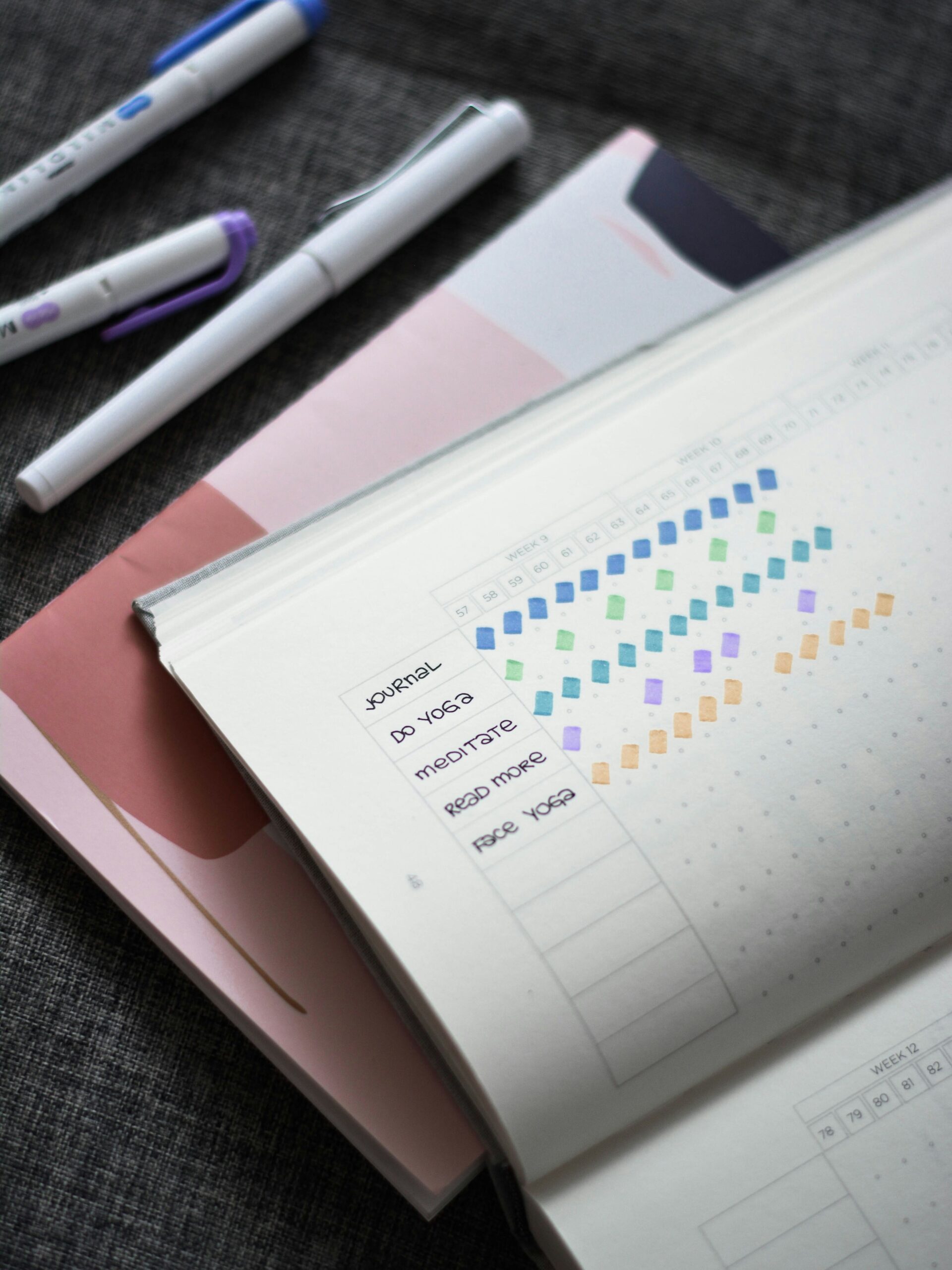When it comes to planning and organizing your life, there are two main options to choose from: digital planners and paper planners. Each has its own set of advantages and disadvantages. In this article, we will discuss the pros and cons of both options to help you decide which one is the best fit for your needs.
Digital Planner
What is Digital Planning?
Digital planning uses technology, such as apps and software on smartphones, tablets, and computers, to organize tasks, appointments, and notes. It’s a modern approach to planning, offering flexibility and efficiency.
Pros of Digital Planning:
- Accessibility: With digital planning, your schedule is always at your fingertips, accessible on any device. This means you can check your calendar or to-do list anywhere, anytime.
- Editability: Making changes to your plans is effortless. You can move appointments or adjust tasks without messy cross-outs, making your planner look neat and organized.
- Backups and Sync: Losing your planner doesn’t mean losing your data. Digital planners often sync to the cloud, allowing for easy recovery and ensuring your information is safe.
- Reminders and Notifications: Never miss an appointment or deadline again. Digital planners can send you reminders, so you’re always on top of your tasks.
- Sharing and Collaboration: Planning something with others? Digital planners make it easy to share your schedule or collaborate on tasks with friends, family, or colleagues.
- Unlimited Space: Unlike paper planners, digital ones don’t run out of space. You can add as many tasks, notes, and appointments as you need without worrying about physical limitations.
- Eco-friendly: By going digital, you reduce the need for physical paper and pens, making it a more environmentally friendly option.
- Integration: Digital planners can integrate with other apps and services, consolidating your tasks, emails, and events in one place. This makes managing your life even more seamless.
Cons of Digital Planning:
- Dependence on Technology: Your planning is only as reliable as your device’s battery life and access to the internet. If your device dies or you’re in an area without internet, accessing your plans can be difficult.
- Distractions: Smartphones and computers are gateways to endless distractions, from social media notifications to email alerts. These can interrupt your planning process or divert your focus from important tasks.
- Learning Curve: Some digital planning tools come with a variety of features that can be overwhelming for new users. The time it takes to learn these can be a deterrent for some people.
- Eye Strain and Screen Time: Prolonged use of digital devices can lead to eye strain and increase your overall screen time, which can have negative effects on your sleep and health.
- Privacy and Security Risks: Storing your personal information in digital form exposes you to potential privacy and security risks. Data breaches can lead to sensitive information being leaked.
- Less Personal: For some, typing into a digital device doesn’t offer the same personal connection or satisfaction as writing by hand.
- Cost: High-quality digital planning tools and apps often come with a price, whether it’s a one-time purchase or a subscription fee.
- Environmental Impact: While digital planning reduces paper use, the production and disposal of electronic devices have a significant environmental footprint.
Paper Planner
What is Paper Planning?
Paper planning involves using physical tools like notebooks, diaries, and planners to organize your life. It’s a traditional method that many find satisfying and effective.
Pros of Paper Planning:
- Tangible Experience: The act of writing by hand can reinforce memory retention and offers a personal touch that many find irreplaceable.
- No Distractions: Paper planners keep you focused on planning without the interruptions of notifications, emails, or social media.
- No Battery Required: Paper planners are always on, never needing a charge or battery replacement, making them reliable at all times.
- Creativity and Personalization: Paper planning allows for a level of creativity and personalization that digital planners can’t match. Stickers, colored pens, and drawings can make planning a more enjoyable and expressive activity.
- Privacy and Security: With a paper planner, there’s no risk of digital data breaches or privacy concerns. Your information is as secure as the physical book it’s written in.
- Simplicity: For those who prefer a straightforward approach to planning, paper planners offer simplicity without the complexity or learning curve of digital apps.
- Physical Backup: In a digital age, having a physical record of your plans and notes can be reassuring. Even if technology fails, your paper planner remains intact.
- Sense of Accomplishment: Physically crossing out completed tasks or turning the page on a finished month offers a tangible sense of accomplishment and progress.
Cons of Paper Planning:
- Physical Bulk and Weight: Carrying a paper planner, especially a large or thick one, adds extra bulk and weight to your bag, which can be inconvenient.
- Risk of Loss or Damage: If your paper planner is lost, stolen, or damaged (e.g., water spill), all your information can be lost without any backup.
- Limited Space: You’re confined to the space provided by the planner. Once it’s filled, you need to carry additional notebooks or wait until the next cycle (e.g., the next year) for more space.
- Lack of Backups: Unlike digital plans, there’s no cloud backup for a paper planner. If it’s gone, all the information is irretrievably lost.
- No Reminders or Alerts: Paper planners cannot alert you to upcoming appointments or deadlines, increasing the risk of forgetting important tasks or meetings.
- Time-Consuming Updates: Rescheduling or shifting tasks involves physically rewriting them, which can be time-consuming compared to the drag-and-drop simplicity of digital tools.
- Environmental Impact: Regularly purchasing new planners, notebooks, and pens contributes to paper waste and environmental degradation.
- No Sharing or Collaboration: It’s difficult to share information from a paper planner with others or collaborate on plans without physically meeting or duplicating the information digitally.
How to Choose Between Digital and Paper Planning
Choosing between digital and paper planning is a personal decision that significantly impacts your daily productivity and overall organization. To make the best choice, consider your lifestyle, habits, needs, and preferences. Here are some guidelines to help you navigate this decision:
Assess Your Lifestyle
- Mobility: If you’re always on the go, digital planning might be more practical. It allows you to access your plans anywhere, anytime, from your phone or tablet.
- Work Environment: Consider if your work or personal life is more tech-oriented or traditional. For tech-heavy environments, digital planners integrate easily with other tools. In more traditional settings, a paper planner might feel more natural and be more practical.
Reflect on Your Habits and Preferences
- Writing vs. Typing: Do you enjoy the act of writing by hand, or do you prefer typing? Writing can aid memory retention, but typing is faster for many.
- Visual Creativity: If you love decorating, coloring, and visually planning out your life, paper planners offer a canvas digital planners can’t match.
- Tech Comfort Level: Are you comfortable navigating apps and digital tools, or do you prefer the simplicity and tangibility of paper?
Consider Your Needs
- Sharing and Collaboration: If you frequently need to share schedules or collaborate on plans with others, digital planners are more efficient.
- Reminders and Alerts: Those who need reminders for appointments and deadlines will benefit from the alert capabilities of digital planners.
- Space and Flexibility: If you require a lot of space or the flexibility to change plans frequently without creating a mess, digital planning offers unlimited space and easy edits.
Evaluate the Pros and Cons
Weigh the advantages and disadvantages of both digital and paper planning in relation to your personal context. Consider factors like convenience, risk of loss, environmental impact, and the personal satisfaction you get from using the planner.
Try a Hybrid Approach
If you’re still undecided, consider a hybrid approach. Use digital planning for its convenience, backups, and sharing capabilities while enjoying the tactile experience and creativity of paper planning for personal reflections, brainstorming, or certain aspects of your life like journaling.
Test and Adjust
Remember, what works best for someone else might not be the best for you. It’s okay to try one method and switch to another or adjust your approach over time as your needs change. The goal is to find a system that helps you stay organized, productive, and aligned with your personal and professional goals.
Conclusion
Choosing the right planning method is about finding the balance that suits your lifestyle, preferences, and needs. By considering these factors and testing what works best for you, you can select a planning system that enhances your organization, productivity, and peace of mind. Whether you choose digital, paper, or a mix of both, the most important aspect is that it supports you in achieving your goals and managing your daily life effectively.



